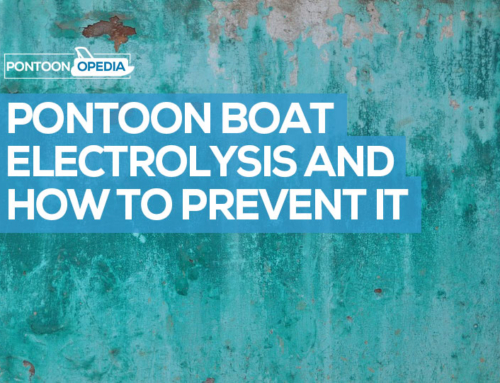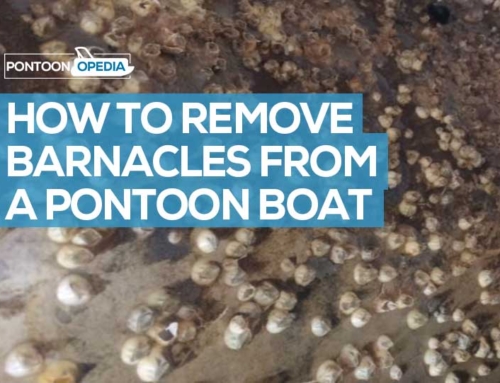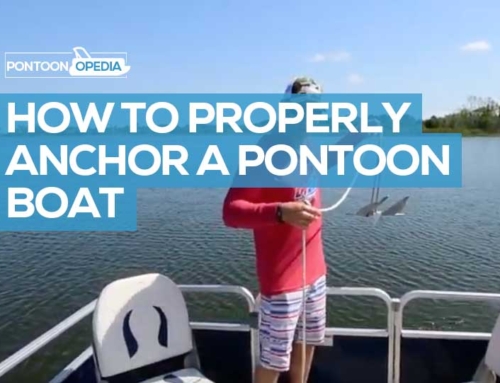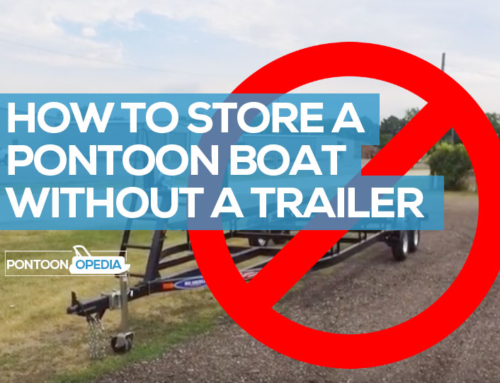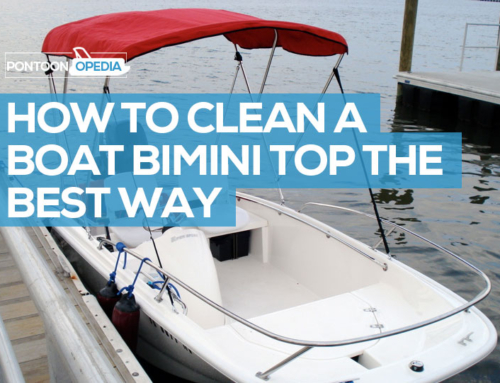When I first bought my pontoon boat back in 2016 I couldn’t wait to get out on the water. Unfortunately, I had almost zero experience of boating, and knew that parking and docking was going to be one my biggest challenges.
I needed fenders and bumpers for sure.
But I had no idea what size fenders I should buy and how far apart they should be spaced, so I did a little research.
Here’s what I found out after researching online and talking with more experienced pontoon owners. I hope it helps you too!
The right sized fenders for a pontoon boat should have 1 inch of diameter for every 5 foot of boat length you have. So, if it’s a 20-foot pontoon your fenders should have a girth of 5 inches.
3 Factors to Determine Pontoon Fender Size
There are 3 main points you need to consider when choosing the right type of fender for your pontoon boat.
- Boat length
- Boat weight
- Mooring conditions
Let’s look at those aspects in a little more detail.
How Boat Length Dictates Fender Size & Position
If you decide to choose cylindrical fenders, and these are very popular although not my preferred choice for a pontoon boat, then here’s a rule of thumb guide.
Rule of Thumb: A cylindrical fender should have 1 inch of diameter for every 4 to 5 foot of boat length. If it’s a round fender, then that diameter should instead be 2 inches.
As a real-world example, a 20-foot pontoon boat would need a fender with at least 4 to 5 inches of girth.
If using cylindrical or round fenders on your pontoon here are some rough guidelines to bumper size based on how long your boat is.
| Pontoon Length | Cylindrical Fender Diameter | Round Fender Diameter | Fender Type |
|---|---|---|---|
| 10 to 15 feet | 3 o 4 inches | 9 inches | Cylindrical Double-Eye, Hybrid |
| 15 to 20 feet | 5 to 5.5 inches | 12 inches | Cylindrical Double-Eye, Center Hole, Hybrid |
| 20 to 25 feet | 6 to 6.5 inches | 15 inches | Cylindrical Double-Eye, Center Hole, Hybrid, Round |
| 25 to 35 feet | 8 to 8.5 inches | 18 inches | Cylindrical Double-Eye, Center Hole, Hybrid, Round |
Common sense should also be a factor here.
For example, let’s say you have a really heavy pontoon or you are going to be docking in harsh conditions such as an open lake prone to high winds, then you should choose larger fenders.
How Many Fenders Will You Need?
To get the best from your new bumpers and fenders you should have the correct number and place them in the best positions.
There’s another generic rule you should apply when deciding where the fenders should be placed and positioned on your pontoon which goes like this:
Rule of Thumb: Place one fender at every 10 foot of waterline, with a minimum of 3 fenders along one side of your pontoon boat
As a real-world example, let’s say you have a 20-foot Bennington or Avalon pontoon then that will need 3 fenders. If it’s a 40-foot boat, then it will need 4 fenders.
Where to Place the Fenders on a Pontoon?
As discussed, you will need to have a minimum of 3 fenders along one side of your pontoon boat.
- Place one at the widest beam point
- Place one at the fore
- Place one at the aft
Obviously if your pontoon is longer, then you will need more as per the guidance in the previous section where I recommend one fender for every 10 foot of waterline.
If you decide to use hanging fenders, then let the bottom of the fender just touch the top of the water surface.
This will stop the dock from pushing the fender up and out of position and will also help to prevent the growth of algae on your new clean bumpers.
Tie the fenders to a solid anchor point such as a cleat or clip and as low as possible on the boat. This will keep them in position and ensure that aren’t exposed to stress and damage.
Handy Hint: Take a look some fender clips and hangers which will make using your correctly sized fenders so much easier.
What Fenders Should You Buy?
I’ve spoken a lot about cylindrical fenders in this sizing guide, but in reality, you should choose specialist pontoon fenders which have been made for the specifics that a pontoon design has.
The best option by far are the Taylor Made pontoon fenders, and you can read more about them in my larger guide to pontoon fenders.
If you want to go buy them now, then take a look on Amazon (view Taylor Made on Amazon) as they have them in stock right now and tend to have very good prices compared your local marine store.
They have grooves and loops for securing them top and bottom to your pontoon.
They then wedge very neatly between the deck and the log, and work great, rather than having cylindrical fenders hanging down off the boat which can look very ugly.
You then get a nice and tight fit which will protect your pontoon whilst in dock. The straps ensure that it stays on tight and won’t kick back and forth along the side of the pontoon like other standard fenders might do.
Here’s a great video that shows just how simple they are to install.
My Recommended Pontoon Fenders
Taylor Made are without doubt the best manufacturer, with fenders of the correct size to be used with any pontoon boat on the market.
Here’s a guidance table I have developed that explains the differences between different fender types, including the pros and cons to each type.
| Type | Description | Do I Recommend? |
|---|---|---|
| Side Fenders | Designed to fit onto pontoon side railings, they are made from highly-durable material, and can withstand a lot of punishment whilst protecting your boat. | Yes! These are 100% recommended as they will help to protect the side railings and framework that appears on all pontoon boats. Click here for my recommendation. |
| Fence-Saver Fenders | These are longer in depth than other pontoon boat bumpers as they drop all the way down to protect the aluminum railings found on this type of vessel. | Yes! These are a must if you want to protect your fencing. They attach very securely and come with straps for added reliability. Click here for my recommendation. |
| Corner Fenders | You would buy these to replace pontoon boat corner bumpers that are old, damaged, or lost. They are designed to blend seamlessly into the design of your boat. | Yes! They are ideal pontoon bumpers, but when you buy make sure you get the correct ones to fit your boat. Taylor Made make awesome ones, here’s my recommendation. |
| Cylindrical Fenders | These are commonly used on small boats. Cylindrical in shape, they have little eyelets on to thread rope through. They can be threaded length ways or will hang. | No! They will work, but I don’t recommend them as they are complex to arrange and require more maintenance. |
| Ball Cylinders | Most of the time you will see these being used on powerboats and commercial fishing boats. They are attached using just the one line per fender and are hollow. | No! For pontooners these are going to be too large and can move around a lot, and honestly won’t look great on your boat. |
| Transom Fenders | Designed to protect the transom of your boat, you will commonly see these being attached to swimming platforms if on a pontoon. They are not designed to fit onto rails. | No! Quite simply, you’re going to struggle with them as they are very large, can split, and aren’t easy to store on your pontoon boat when not being used. |
| Flat Fenders | Modular by nature, you can buy as many as you like and fit them together to suit your boat’s configuration. They stick flat to the side of your boat once attached. | No! For me they tend to be cheap and nasty looking and can tear as well. They are not as robust as other pontoon fender bumpers on the market. |
Should You Use Orange Round Ball Buoys?
I’ve seen plenty of pontoons use orange ball buoys.
The look ugly and cheap, don’t they?
The only time I would use them would be when rafting; which means when you tie up against another boat.
If you are going to be tying up to another pontoon, then here’s where you would need them.
I’d recommend using 3 standard fenders at maximum beam, then a round orange ball fender at both aft and fore.
Handy Hint: I also recommend that you buy fender adjusters as this will make adjusting the height of the bumpers plus bringing them back into the boat way easier.
Final Thoughts
Having the right size, number, and type of fender on your pontoon boat can be the difference between thousands of dollars.
By that I mean you can easily damage your pontoon if you don’t quite dock it properly, and if I’m honest, even the most experienced of captains will have a prang now and again.
It’s not just your own mistakes you can protect by having the correct sized fenders in place, you also need to mitigate damage to your pontoon from other boat owners.
Handy Hint: Keep your fenders looking in great condition with regular cleaning. Read my guide on how to clean boat fenders.
Not all of your neighbors on the lake will have fenders attached, and even if they do they could be attached incorrectly leading to dents, scrapes, and dings when up close and personal to you and your much-loved boat.
They are an inexpensive way to keep your boat safe whist moored and a must-have pontoon accessory.
I would certainly buy a few spares, and above all make sure that you have the correct size and they are positioned or deployed correctly.
I also recommend that you keep them clean, as nothing looks worse than dirty fenders.
Simply clean them soap and water and don’t use any chemical agents as this can not only damage them, but also harm the local marine life in your local lake or rivers. You can also buy specialist washable fender covers if you want to take things to the next level of cleanliness.
You won’t regret having them installed, particularly the next time you rock up to the local pontoon party, beach your boat at a popular location, or possibly just come into the dock just a little bit too fast!
You might also find this video useful as it’s where I gained most of my own insight from.



